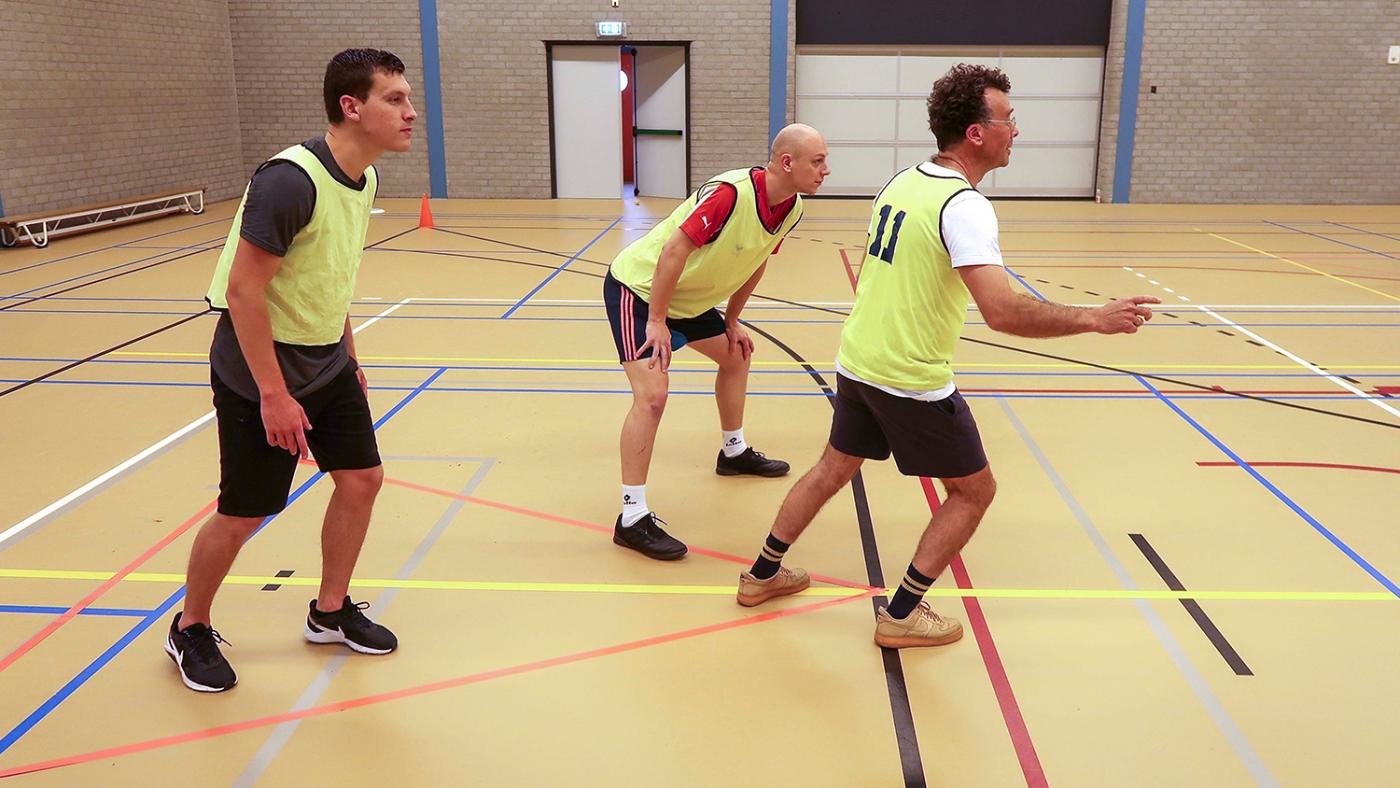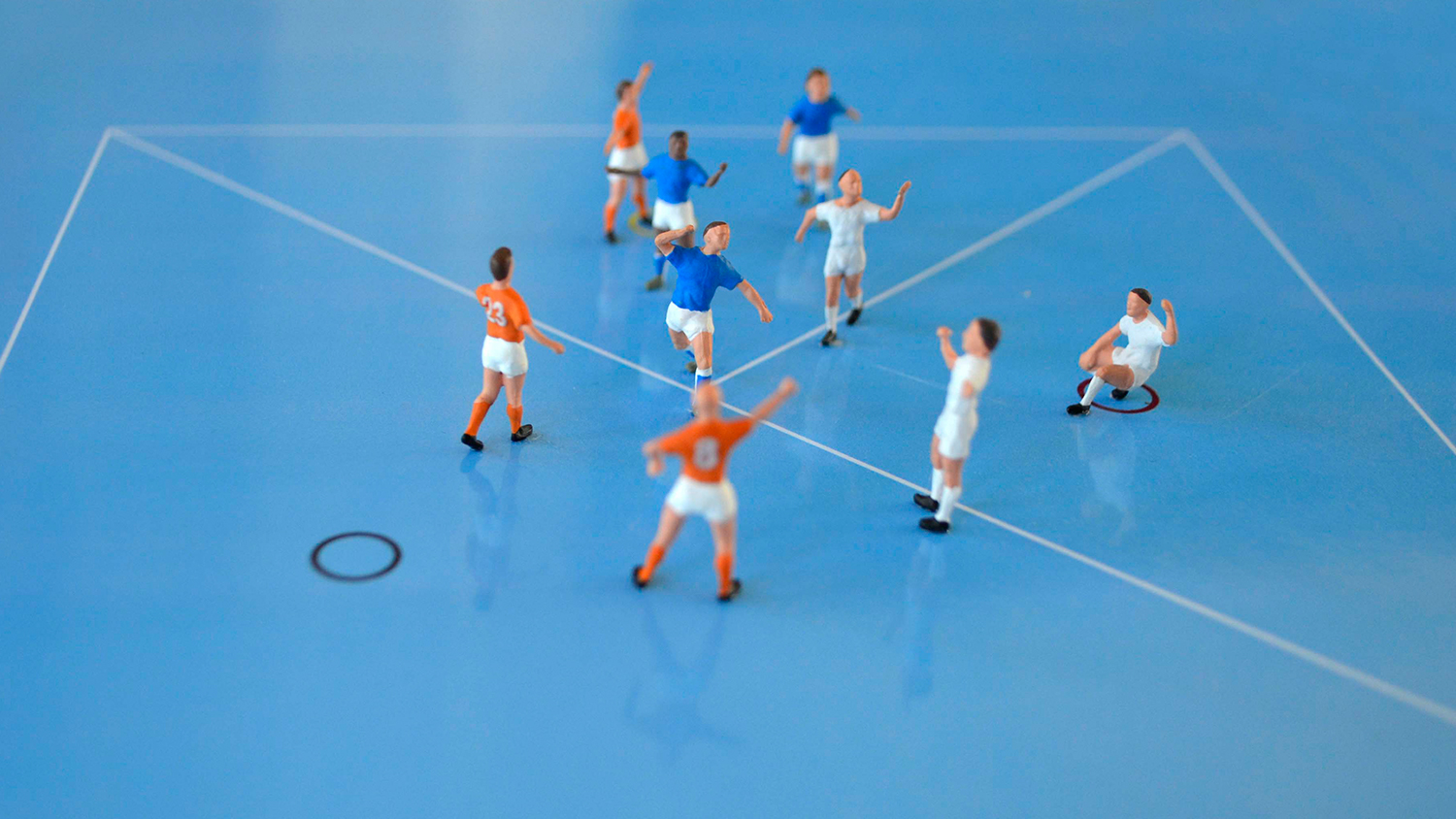'Sports should unite us', creators of Qontrol-ball say

Assistant professor Michel van Slobbe and student Bradley Hermsen are two of the creators of the new sport Qontrol-ball. They are part of the team of researchers and students of the Master’s Sports policy & Sports management that has devised the new sport after a call from popular science magazine Quest. The creators had to work with the specific criteria journalist Mark Traa, of Quest, has set. After some ups and downs, they arrived at Qontrol-ball.
The things that makes Qontrol-ball unique, is that it is played with three teams and that the rules are highly strategic. The three teams play on one field, which is divided into three triangles: a big one, and two smaller ones. Each team defends ‘their’ triangle and the circle in the middle of the triangle, which is the goal. Players can score by catching the ‘ball’, while standing in one of the other teams’ circle. After each goal, each team is switched around to a different triangle. There is no ‘normal’ ball, but rather a ball with bumps. When a player passes the ball to a different player, they must bounce it at least once. Thank to the bumps, the direction of the ball after the bounce can be unpredictable. One needs a quick response time. Two of the three teams can form a bond, which makes strategy an important part of the game. The name ‘Qontrol’ alludes to the controlling of the bumpy ball, the ‘Q’ comes from Quest.

How did this challenge start for you?
Michel van Slobbe: “Mark van Traa came up with the idea in Quest. He approaches sports from a scientific angle, and wondered whether one could come up with a new sport and what that would entail. He came into contact with professor Maarten van Bottenburg, who then put that question to us. We wondered, ‘What can we do with this?’ We quickly figured out that the question was rather ambitious, because sports have kept developing over time. They have adjusted to the times, with new wishes and expectations. Think of volleyball and beachball for instance, or city sports such as free running. Each time, there is a new variation on an existing sport. So we thought: ‘It is undoable to come up with something entirely new’. Still, the question kept intriguing us. We went into this challenge as though it was an experiment, a laboratory approach. Bradley, do you remember how we went about it? The start?”
Bradley Hermsen: “If I remember correctly, Maarten send me an e-mail, just like other students in the Master’s. He asked us who of us wanted to work on the Quest question. It was during Covid, and we were just about able to meet up in person again. The social aspect was important to me in this challenge: just doing things together with students and teachers again. The fun part was that students and teachers started the process at the same level: nobody had any prior knowledge. Our teachers are all experts in their respective fields, but we basically all went into this challenge in the same way. The question was new for all of us.”

You had to adhere to specific criteria. What were those, and have you added on rules of your own?
Bradley: “Quest asked us to not use a ball, for instance. It also had to be played by men and women together, and not resemble an existing sport. What I liked was the tension that arose: we could not do everything right for everyone. Lisa, one of the students that participated, works in disabled sports. She thought it was important that the final product had to be able to be played by disabled people, but along the way we had to let go of that criterium. Also the wish to not use a ball was overridden eventually. We thought about that for a long time, but eventually we still ended up with a ball. A ball is a very recognizable thing in a sport.”
But not a usual ball, right?
Bradley: “No, at one of the brainstorm sessions, Fenne, another student, had brought a ball with bumps. We started throwing and bouncing it, and we noticed that it was a very new thing for all of us. We wanted to use that in some way. The nice thing about the ball is the unpredictability I think, which is also an attribute for sports to me. That also makes it fun for any spectators.”

If the ball is that unpredictable, can you really train for a match?
Bradley: “Certainly you can. Just like with other sports, Qontrol-ball can be mastered by practicing it. For Qontrol-ball, it helps if you are in good shape, have good hand-eye coordination and work together well as a team. All of those elements can be honed by training.”
Do you think Qontrol-ball will be played at Olympus eventually, for instance?
Van Slobbe: “That is an interesting question for those who study the sport for Public Administration and Organizational Sciences. What makes one iteration of a sport a success, and others not? Studies show that popularization, or a lot of media attention, and a high level of organization are important for the development of a sport. But to be honest, we just like playing. Bradley, do you remember at the start, when you read the Quest-article and was a bit put off by how complicated it was? GeenStijl wrote ‘a sport created by and for nerds’. The funny thing is that when you finally get to playing it, it quickly becomes clear what you have to be able to do and know. The ball’s unpredictable twist and the quick movement to get in your opponent’s circle to score. We thought it was really tiring too, after playing for half an hour. We think that is the maximum playing time.”

Bradley: “It’s really intense, yes. What I also like about this sport is that you keep on hearing about children who nowadays don’t move around as much and have less hand-eye coordination. Qontrol-ball is a port in which mainly the use of the ball with the six bumps is challenging. Although the bumpy ball is fun, the sport can also be played with a normal tennis ball, by young children for instance. The rules are exactly the same. You pass to each other by bouncing the ball, only the spot where a tennis ball would land is more predictable. If children get the hang of that and would like an extra challenge, they can replace the tennis ball with the bumpy ball. In that way, you can differentiate Qontrol-ball for different people. You could also make the playing field larger or smaller.”
Bradley, you like soccer, would you forego that for Qontrol-ball?
Bradley: “Dangerous question! Soccer is my passion, but mainly because of everything that comes with it.”
Van Slobbe: “It’s not just the specifics of the game that make a sport, but also the way it unites people.”
Whether something like a ‘soccer culture’ will come to exist for Qontrol-ball is still an unknown for them. In any case, the call from Quest has lead to 120 enthusiastic people who have said that they want to play the sport some time. The first live demonstration with spectators will take place in the Zomerstadion (Summer stadium) from Sportworx from August 31st until September 25th, at the Jaarbeursplein in Utrecht.